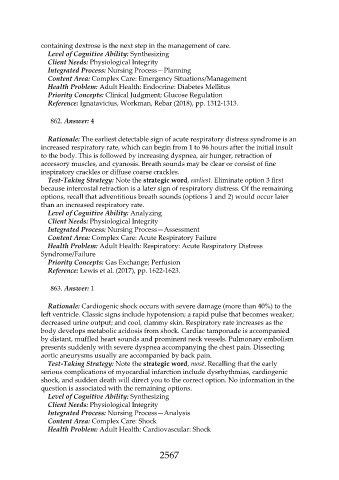Page 2567 - Saunders Comprehensive Review For NCLEX-RN
P. 2567
containing dextrose is the next step in the management of care.
Level of Cognitive Ability: Synthesizing
Client Needs: Physiological Integrity
Integrated Process: Nursing Process—Planning
Content Area: Complex Care: Emergency Situations/Management
Health Problem: Adult Health: Endocrine: Diabetes Mellitus
Priority Concepts: Clinical Judgment; Glucose Regulation
Reference: Ignatavicius, Workman, Rebar (2018), pp. 1312-1313.
862. Answer: 4
Rationale: The earliest detectable sign of acute respiratory distress syndrome is an
increased respiratory rate, which can begin from 1 to 96 hours after the initial insult
to the body. This is followed by increasing dyspnea, air hunger, retraction of
accessory muscles, and cyanosis. Breath sounds may be clear or consist of fine
inspiratory crackles or diffuse coarse crackles.
Test-Taking Strategy: Note the strategic word, earliest. Eliminate option 3 first
because intercostal retraction is a later sign of respiratory distress. Of the remaining
options, recall that adventitious breath sounds (options 1 and 2) would occur later
than an increased respiratory rate.
Level of Cognitive Ability: Analyzing
Client Needs: Physiological Integrity
Integrated Process: Nursing Process—Assessment
Content Area: Complex Care: Acute Respiratory Failure
Health Problem: Adult Health: Respiratory: Acute Respiratory Distress
Syndrome/Failure
Priority Concepts: Gas Exchange; Perfusion
Reference: Lewis et al. (2017), pp. 1622-1623.
863. Answer: 1
Rationale: Cardiogenic shock occurs with severe damage (more than 40%) to the
left ventricle. Classic signs include hypotension; a rapid pulse that becomes weaker;
decreased urine output; and cool, clammy skin. Respiratory rate increases as the
body develops metabolic acidosis from shock. Cardiac tamponade is accompanied
by distant, muffled heart sounds and prominent neck vessels. Pulmonary embolism
presents suddenly with severe dyspnea accompanying the chest pain. Dissecting
aortic aneurysms usually are accompanied by back pain.
Test-Taking Strategy: Note the strategic word, most. Recalling that the early
serious complications of myocardial infarction include dysrhythmias, cardiogenic
shock, and sudden death will direct you to the correct option. No information in the
question is associated with the remaining options.
Level of Cognitive Ability: Synthesizing
Client Needs: Physiological Integrity
Integrated Process: Nursing Process—Analysis
Content Area: Complex Care: Shock
Health Problem: Adult Health: Cardiovascular: Shock
2567

